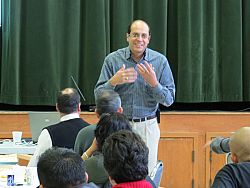How-to on bringing diverse cultures together
SALT LAKE CITY — The cultural diversity of the Diocese of Salt Lake City poses challenges for parishes as they seek to build bridges between their various groups. Suggestions on how to do just that were given at two workshops held April 26-27 at the Madeleine Choir School, presented by Alejandro Aguilera-Titus, assistant director in the Office of Cultural Diversity at the U.S. Conference of Catholic Bishops. "I decided to bring Alejandro because I think his topic is very relevant to our diocese," said Samantha Almanza, director of the diocese’s Youth and Young Adult Ministries. "We have a beautifully diverse diocese, and his topic is weaving together ministries in diverse parishes." Also, when Almanza asked diocesan youth ministers what topic they wanted addressed, "the number one response was how to integrate or bring together different groups in our parish for youth ministry," she said. One of the workshops was offered in English, the other in Spanish. While Aguilera-Titus’ presentation was focused on youth ministry, it had wider applications. "I took lots of notes," said Cathy Cummings, faith formation director for Saint Rose of Lima Parish. "I’m not here for just the youth group. I’m here for the adults as well. The adults need as much faith-building as do the children." St. Rose of Lima Parish has distinct Hispanic and Anglo communities, and bringing them together is important, Cummings said. One of the steps that Aguilera-Titus presented was creating spaces for everyone in the parish to feel welcome, and "I like his idea that you can have separate [events], yet bring them together so that everyone feels comfortable with themselves and then come together as a community to do other things," she said. To bridge cultures, the parish community first must welcome others, Aguilera-Titus said. "People cannot be in solidarity with one another if they don’t have a sense of community with one another, if we don’t know each other." Also, newcomers must be able to develop a sense of belonging and ownership in the parish, Aguilera-Titus said. "Once you decide to … invite people, the Holy Spirit is moving," he said, adding that this is what Christians are called to do. "The Church is not an end to itself. The Church exists to sanctify the world to God, to make this world more what God intended this world to be like from the beginning. That is our job." Functions such as Mass in Spanish don’t divide the community but rather serve the people by allowing them to go where they are comfortable, Aguilera-Titus said; if such a Mass isn’t offered some people will decide to go to a different parish, which does divide the community. The established community may feel resentment toward the newcomers, creating an "us/them" situation, but "in Christ, through their Catholic identity, they are called to be one with one another, so the great mystery of the faith is what happens when they are brought together," Aguilera-Titus said. One temptation to be avoided is developing parallel ministries that never join together, he said. To counter this, "at some point you need to say, ‘We need to intentionally come together, get to know one another, exchange ideas, share stories, share experiences. That is what we need to do.’ … When these two communities are working side by side, they build. … There is a great reality: that in God’s church, there is room for everyone." Among those who attended Aguilera-Titus’ presentation was Orlando Avila, the youth minister at Saint Ann Parish. "It gives me an idea of how to approach [the youth], to get them involved without pushing them, and not so much telling them what to do but welcoming them in and having a conversation with them," he said.
© Copyright 2024 The Diocese of Salt Lake City. All rights reserved.


Stay Connected With Us